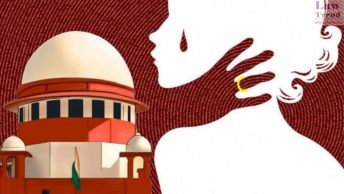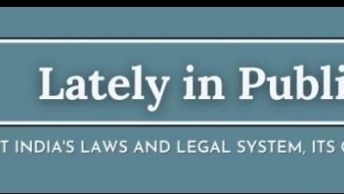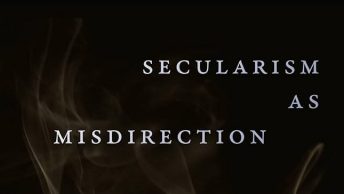Over the last few days, there has been considerable discussion of the controversial use by the BJP of the original, unamended Preamble to the Constitution of India in an advertisement campaign. See, for instance, the views of Upendra Baxi and Salil Tripathi on this issue. In the following guest post, Arvind Narrain of the Alternative Law Forum sets out his view on the questions involved.
The present political dispensation hinting that
they would go by the unamended version of the preamble (which did not have the
words socialist and secular in it) has stirred the pot of controversy.
articulated by Ravi Shankar Prasad who as reported by the Hindu (29.1.15) argued
that the amended preamble is inauthentic. The inauthenticity according to Ravi
Shankar Prasad resides in two factors: the first being that the framers of the Constitution did not
deem the two words in controversy, socialism and secularism, necessary and
secondly that the words came in as part of the emergency during Indira Gandhi’s
authoritarian rule. Under pressure from various quarters for his statement as
reported in the Hindu, Ravi Shankar Prasad claimed in a clarificatory statement that he had been misquoted. However regardless
of the withdrawal, the reasons articulated
by the Minister in his initial reported statement need to be critiqued as those
reasons continue to be cited in support of the demand to replace the preamble
with the unamended version.
amended has been answered by the Supreme Court in Kesavananda Bharti where the Court held that all parts of the
Constitution including the Preamble can be amended save what is “the basic structure or framework of the
Constitution.”
legitimacy of constitutional
amendment was well articulated by Justice Khanna in Kesavananda who quotes Thomas Jefferson to opine that:
generation according to Jefferson should be considered as a distinct nation and
with a right by the will of the majority to bind themselves but none to bind
the succeeding generations, more than the inhabitants of another country. The
earth belongs in usufruct to the living and the dead have neither power nor the
right over it.
change the constitution is the limitation imposed by the basic structure
doctrine. One way of understanding the doctrine of basic structure is that it
is a way of limiting parliamentary power in a country which has minorities of
many stripes and hues. By limiting the
power of parliament to amend, the Court is recognizing that giving unlimited
power to an institution which functions on the basis of the power of the
majority, will put minority rights at the mercy of majority whims and fancies. Kesavananda
is deeply concerned about the dangers of unbridled majoritarianism and what it
can do to the concept of a diverse and plural India.
no hint anywhere that abrogation of minorities rights was ever in the
contemplation of the important members of the Constituent Assembly. It seems to
me that in the context of the British Plan, the setting up of the Minorities
Sub- Committee, the Advisory Committee and the proceedings of these committees
as well as the proceedings of the Constituent Assembly mentioned above, it is possible
to read the expression ‘amendment of the Constitution’ as empowering parliament
to abrogate the rights of minorities.
constitution was framed on the basis of consensus and not on the basis of
majority votes. It provides for the protection of the minorities. If the
majority opinion is taken as the guiding factor then the guarantees given to
the minorities may become valueless.
equally concerned about what those with economic power can do to those who lack
economic resources. Within Kesavananda’s
perspective, a political majority which is based upon the wealth of the few can
be deeply injurious to the lives of the many. To protect those who would
otherwise be at the receiving end of an economically powerful political majority, Kesavananda recognises egalitarianism and the welfare state as part
of the basic structure.
As Justices Hegde and Mukerjea opined:
careful consideration of the various aspects of the case, we are convinced that
the parliament has no power to abrogate or emasculate the basic elements or
fundamental features of the Constitution such as the sovereignty of India, the
democratic character of our poli[t]y, the unity of the country, the essential
features of the individual freedoms secured to the citizens. Nor has the
parliament the power to revoke the mandate to build a welfare state and
egalitarian society.
basic structure necessarily implies a defence of secularism by Kesavananda. The recognition of
egalitarianism and the welfare state as part of the basic structure implicitly
recognizes that socialism too is part of
the basic structure. As such, the introduction of the words secularism and
socialism through constitutional amendments is not destructive of the
Constitution but rather explicates the basic structure of the Constitution and
hence come within the power of the parliament’s power of amendment.
the Constitution. As Justices Hegde and Mukerjea opine:
these limitations, however, there can be no question the amending power is a
wide power and it reaches every Article and every part of the Constitution.
That power can be used to reshape the Constitution to fulfil the obligations
imposed on the state. It can also be used to reshape the Constitution within
the limits mentioned earlier to make it an effective instrument for social
good. We are unable to agree with the contention that in order to build a
welfare state, it is necessary to destroy some of the human freedoms. That at
any rate is not the perspective of our Constitution.
cannot make the case that the amendments introducing the words socialism and
secularism are tantamount to tampering with the basic features of the
Constitution. In fact the introduction of these words merely makes explicit what is implicit in the
Constitution. This is the unequivocal
conclusion of the Supreme Court in S.R.
Bommai where Justice Ahmedi pronounced that:
the fact that socialist and secular were added in 1976 by Constitutional
amendment, concept of secularism was embedded in our constitutional philosophy.
The amendment made explicit what was implicit. The Preamble itself spoke of
liberty of thought, expression, belief, faith and worship. While granting this
liberty the Preamble promised equality of status and opportunity. The
Constitutional abhorred discrimination on grounds of religion….
Constitution meant originally is disingenuous as there is no conflict between
the original ideals in the preamble and the introduction of the words secular
and socialist through the 42ndamendment.
out of any real love for the Constitution. What the current ruling dispensation
wants to say is they have a problem with
the notion of both secularism and socialism. To invoke the dubious legacy of
the 42nd amendment is to
instrumentalize history, with the sole objective of destroying what they claim
to protect. As such the bluff should be called.
the famous dissent in the Habeus Corpus
case) who in Kesavananda observed
that:
regarding the amendment of the constitution does not furnish a pretence for
subverting the structure of the constitution nor can Article 368 be so
construed as to embody the death wish of the Constitution or provide sanction
for what may perhaps be called its lawful hara-kiri?
Constitution’ and are those in the
forefront of this demand nothing more
than the executioners of the Constitutional idea of India?







This is ludicrous faux outrage of the same sort that characterized the creation of the Venkatachaliah committee during NDA-1. It is preposterous to compare an I&B advertisement with a constitutional amendment & invoke a judgment dealing with the scope of art.368! NDA-2 has neither the numbers nor has it expressed any real desire to amend the preamble. Hyperbolic expressions a la "executioners of the Constitutional idea" do not change these facts.
"and secondly that the words came in as part of the emergency during Indira Gandhi’s authoritarian rule"… eventual admission that at least some good came out of it?